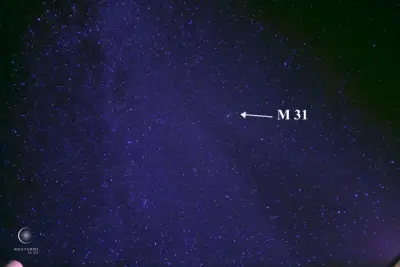What’s up in the sky for November 2025? Leonid meteor shower, full hunter’s supermoon

This iPhone image was taken at sea of the Andromeda Galaxy and approximates the view of the elongated galaxy with your eyes and binoculars WTOP Greg Redfern This iPhone image was taken at sea of the Andromeda Galaxy and approximates the view of the elongated galaxy with your eyes and binoculars WTOP Greg Redfern Welcome to WTOP s monthly feature What s up in the sky Each month it features the best the sky has to offer stargazers regarding the moon planets and stars Space-related events that might interest you taking place in the D C area are included as well Let s get to the sky for November Must-see sky sights for November Full hunter s supermoon is the largest and brightest full moon for The Leonid meteor shower will take place on the night of Nov to Star of the month Capella In November be on the lookout for bright Capella in the northeast It is the first bright winter season star and is beautiful to see rising in the early evening hours Look for it right after it gets dark as it will twinkle with wonderful colors due to being low on the horizon Highlights of the month As November begins the Summer Triangle is headed toward the Western horizon with the Milky Way running through it as it flows across the sky to the northeast As the night heads into the hours before dawn the Winter Milky Way is visible in the southeast to the northwest You can image the Milky Way with a smartphone and or camera by taking time exposures For best results use a tripod The constellation Pegasus the Flying Horse is also known as the Great Square That is because it is a Great Square in the eastern sky after dark It is very easy to see Attached to Pegasus is the constellation of Andromeda More stories China says it s on track to land astronauts on the moon by ahead of space station mission years ago gravitational waves were detected for the first time With pharaoh-fanfare Egypt unveils a huge new museum dedicated to its ancient civilization Following the star chart try to locate a fuzzy spot with your eyes binoculars will help immensely When you find it this is the great Andromeda Galaxy This is the farthest object at million light-years that can be seen with the unaided eye The light from the Andromeda Galaxy that is entering your eye left the galaxy when our ancestors were progressing a curved spine to help us walk more efficiently Pretty amazing Nov As it gets dark Saturn and the almost full moon rise in the East a mere two degrees apart Nov The full hunter supermoon is at p m Eastern Time and rises at sunset in the East This is the first full supermoon of and the largest and brightest full moon of Should be a grand sight at sunset Get your smartphone camera ready Nov Starting at p m and lasting for about hours the bright moon passes through the Pleiades star cluster late in the evening covering occulting specific of the stars Binoculars will enhance the view Nov A must see in the predawn sky in the East is the very old waning crescent moon with Earthshine joining up with Venus at just four degrees apart Try taking a smartphone camera pic Nov While looking at the moon and Venus be on the lookout for the Zodiacal Light For about two weeks it will be visible in the northern hemisphere in the eastern pre-dawn sky and for the southern hemisphere in the west after sunset You will need a dark sky site and clear horizon to see this ghostly pyramid shape in the sky Try taking a smartphone camera pic Night of Nov - The Leonid meteor shower graces our dark moonless sky Check out the tips for seeing the shower video in the article Under these sky conditions the Orionids exhibit a maximum of about to meteors per hour Nov If you have a straight line horizon in the southwest with no obstructions at twilight look to the southwest to see the young waxing crescent moon very near Antares To the lower right and just above the horizon Mercury and dimmer Mars are paired up You will majority of likely need binoculars to see this Try taking a smartphone camera pic The moon Nov Full harvest supermoon Nov Last quarter Nov New moon Nov First quarter Planets Mercury is favorable for Southern Hemisphere viewers at dusk in the west Venus is very low above the eastern horizon before dawn and will become more hard to see as it nears the sun s glare Mars is in the glare of the sun at dusk Jupiter rises in the northeast during the evening hours and is quite bright Saturn is high in the southeast after dark A great view in a telescope as the rings cast a thin line across the planet Uranus is in the eastern sky after dark You need a telescope to best observe the planet although it is visible in binoculars Neptune is in the east as it gets dark You need a telescope to observe the planet Pluto is way out there in the solar system and requires taking images through a telescope spaced days apart to hunt it down DC-area events Shenandoah National Park Shenandoah National Park s Big Meadows is an excellent dark sky site I will be conducting my Let s Talk About Space events at Skyland Lodge Conference Center so hope to see you there NOVAC General Meeting George Mason University Check the calendar for astronomy events The Analemma Society The Analemma Society has resumed observatory operations Check the link regarding Friday Night General Viewing Sessions at Turner Farm in Great Falls Virginia Check their calendar for other astronomy exercises in November Smithsonian National Air and Space Museum The Smithsonian Air and Space Museum in D C and Chantilly Virginia has loads of astronomy stuff in November Other groups holding events in September include Virginia State Parks and the National Capital Astronomers You can check here and here for astronomy clubs that are outside the D C area Bonus Download NASA s Science Calendar that features out-of-this-world pictures and information The Planetary Society s Space Events Calendar is another stock for tracking space missions Use this useful tool to create a custom star chart for your location to help you find your way around the stars You can also send in any space-related questions to my email address Suggestions about this feature are also welcome Follow Greg Redfern on Facebook Bluesky and his daily blog to keep up with the latest news in astronomy and space exploration Source
